Crowded onto steep hills at the Tagus River Estuary, Lisbon is a city bursting with style, world-renowned sights, culture and nightlife.
The cityscape cannot be mistaken for anywhere else, and you can ride those famous yellow trams and funiculars up to belvederes for unforgettable views.
In the 16th century Lisbon was the world’s first global city, as the hub for commerce from Africa, India, the Far East and eventually Brazil.
That period was ushered in by Vasco da Gama’s discovery of a passage to India in 1498, and the affluence it created shines through in the intricate Manueline stonework of the UNESCO-listed Jerónimos Monastery and the nearby Belém Tower.
Another big chapter in Lisbon’s past came around 200 years later, when an earthquake and tsunami in 1755 killed up to 40,000 inhabitants and took out 85% of the city’s buildings.
Under watch of the Marquis of Pombal a new Neoclassical city was constructed to a symmetrical plan, epitomised by the breathtaking Praça do Comércio.
1. Jerónimos Monastery
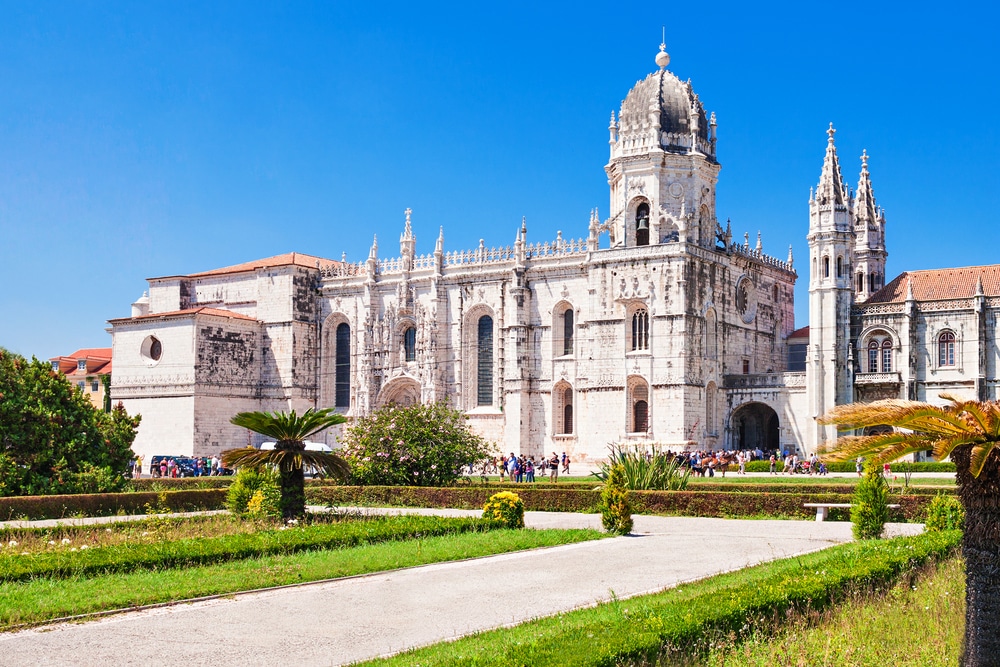 Source: saiko3p / Shutterstock
Source: saiko3p / ShutterstockBuilt throughout the 16th century, the Jerónimos Monastery resonates with Portugal’s sense of confidence during the Age of Discovery.
King Manuel I (1469-1521) funded the project with a tax on commerce with Africa and the Orient, and this wealth is reflected in the opulent Manueline style of its mouldings.
This is most visible on the monastery’s facades, in the exquisite arcades of the two-storey cloisters and at the Church of Santa Maria.
There you can spend a lot of time caught up in the beauty of the south and western portals, teeming with sculpture.
Head in to be wowed by the profusely decorated pillars and star vaults, and to visit the tomb of Vasco da Gama in the lower choir, carved in a neo-Manueline style in the 19th century.
2. Torre de Belém
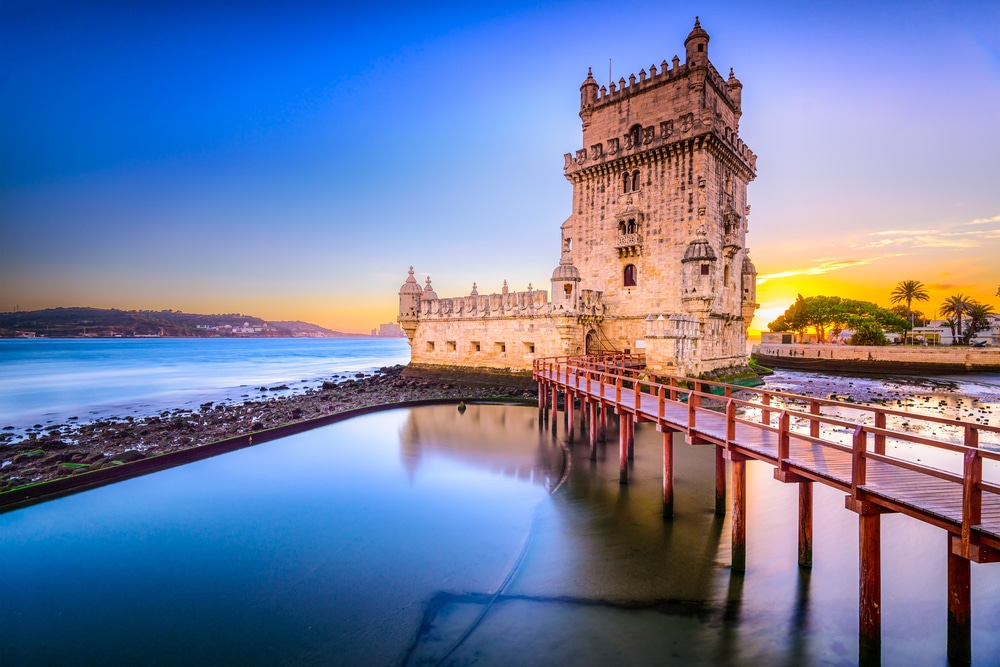 Source: Sean Pavone / Shutterstock
Source: Sean Pavone / ShutterstockIf the monastery piqued your interest in the Manueline style, then your next stop has to be this fortified tower nearby from the 1510s.
It’s hard to exaggerate the significance of the Torre de Belém, both in terms of its architecture and what it meant in the Age of Discovery, as the arrival and departure point for explorers who changed the world.
The tower, armed with cannons in its casemates, is a joint UNESCO World Heritage Site with the monastery and was originally built on an island, since connected to the shore following the 1755 Lisbon earthquake.
Take as much time as you need to appreciate the Manueline stonework, in the dainty balustrades of the loggias, rib vaulting, the pinnacles, the carved merlons, the domes of the bartizans and the portals.
There’s tons of symbolism throughout in the Crosses of the Order of Christ (of which Manuel I was a member) and the carved armillary spheres, denoting Portugal’s navigational superiority.
3. National Museum of Ancient Art (MNAA)
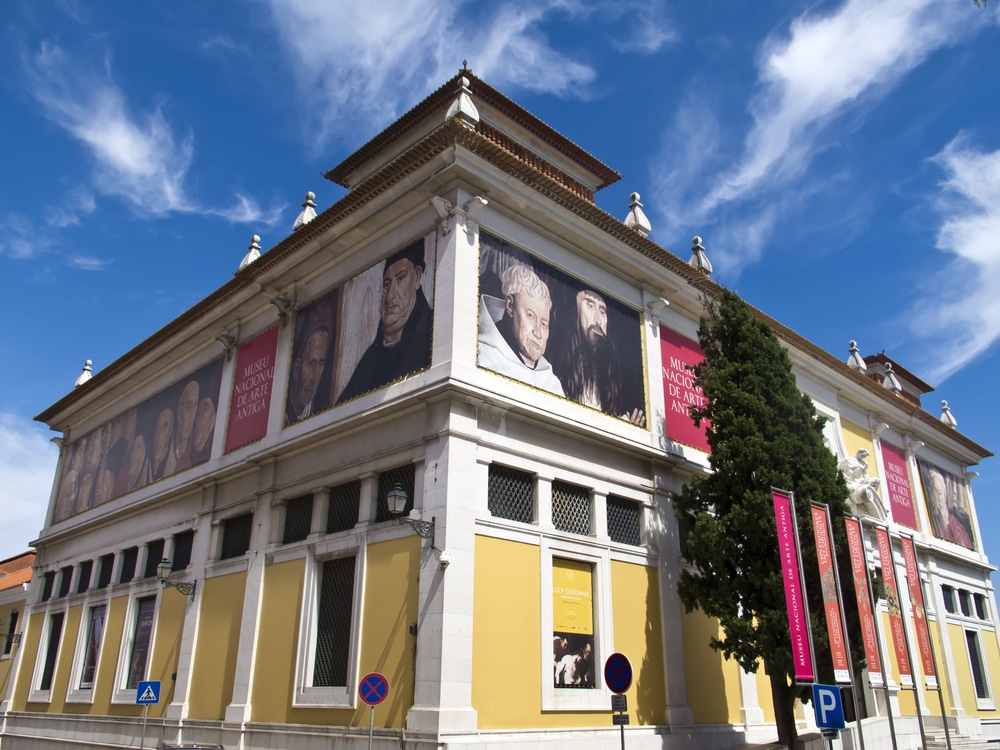 Source: Giancana / Shutterstock
Source: Giancana / ShutterstockAt this world-class museum, Portugal’s most important public art collection is on show in a converted 17th-century palace once home to the Marquis of Pombal, who oversaw Lisbon’s post-earthquake reconstruction.
The collection, which includes a host of Portuguese national treasures, covers more than a thousand years and a whole spectrum of media, from painting, to sculpture, tapestries, goldwork, liturgical art, furniture, oriental decorative art and ceramics.
Just a few of the important European artists represented are Hieronymus Bosch, Tintoretto, Pieter Brueghel the Younger, Poussin, Hans Holbein, Zurbarán, Dürer and Velázquez.
You can also trace the progression of Portuguese painting, and discover lots of compelling evidence expressing the interplay between Portugese and Asian cultures.
This might be 16th-century Nanban screens showing Portuguese merchants doing business in Japan, or 17th-century Chinese Ming vases sporting Portuguese motifs like coats of arms.
Website: http://museudearteantiga.pt/english
4. Alfama
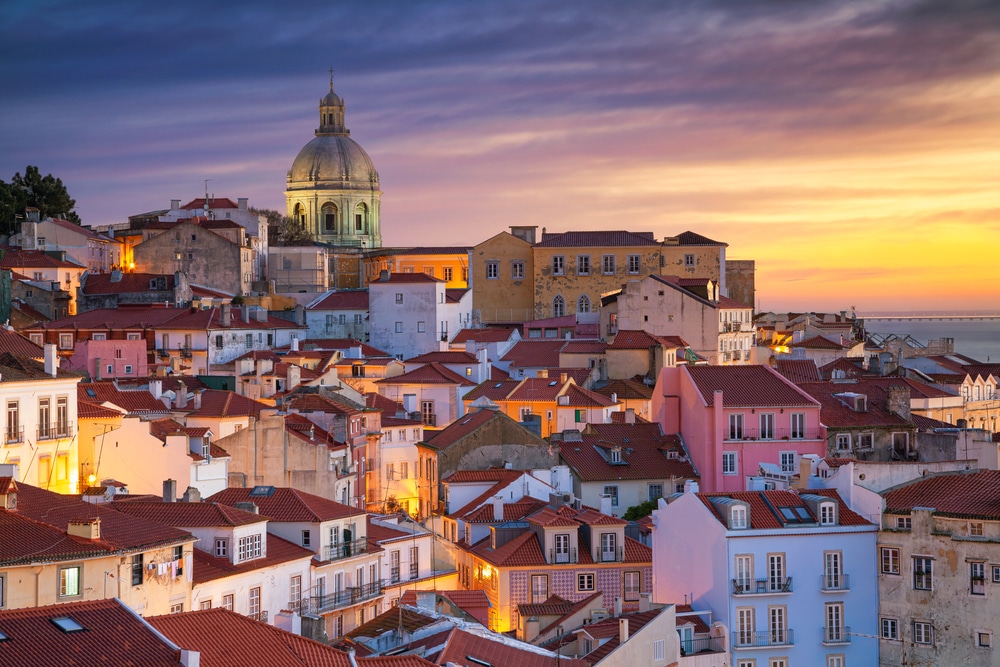 Source: Rudy Balasko / Shutterstock
Source: Rudy Balasko / ShutterstockOn the south face of the hill leading up to the Medieval São Jorge Castle is the oldest neighbourhood in the city, from which the rest of Lisbon developed.
And despite the cataclysmic events that have struck the city over the last millennium, Alfama’s tangle of alleys, courtyards, squares and stairways still has a Medieval flavour.
This is the location for Lisbon’s Romanesque and Gothic cathedral, which we’ll cover in more detail later, as well as the National Pantheon at the Church of Santa Engrácia, where important Portuguese figures are buried, from the footballer Eusébio to the Fado singer Amália Rodrigues.
And while Alfama had long been seen as a down-at-heel neighbourhood, it has come through a revival as a fashionable hangout known for its restaurants and Fado houses.
And with its elevated position come sublime views, as you’ll witness at Largo das Portas do Sol, where you can observe Alfama’s winding streetscape, the Monastery of São Vicente de Fora (burial place of the Braganzas) and the Tagus Estuary.
5. Museu Nacional do Azulejo (National Tile Museum)
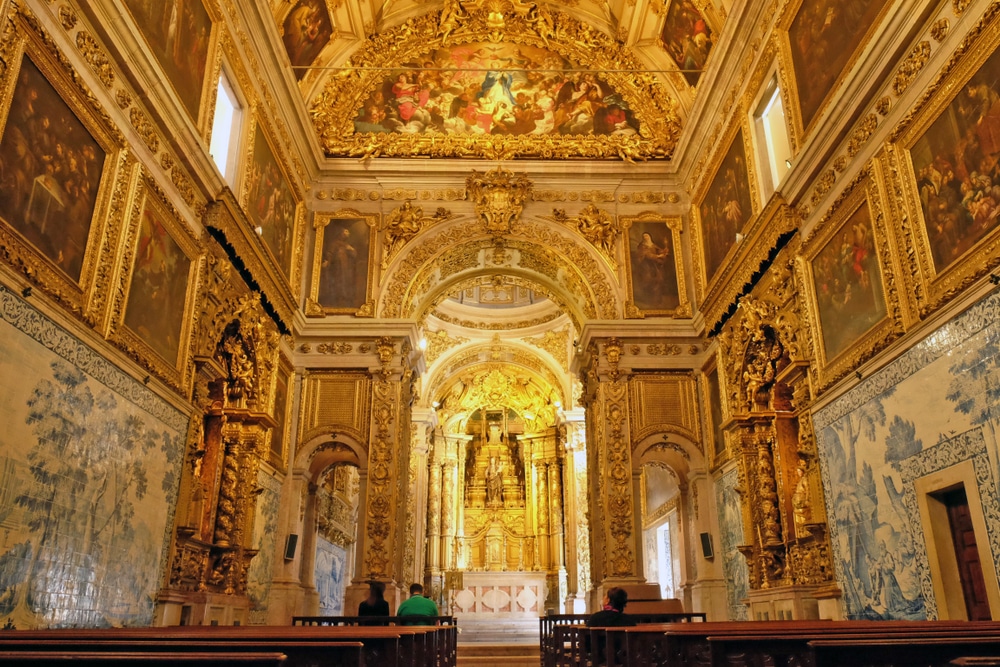 Source: astarik / Shutterstock
Source: astarik / ShutterstockAt this museum in the 16th-century Madre de Deus Convent you can find out everything you need to know about the tin-glazed tiles that are a hallmark of Portugal, Spain and the entire Iberophone world.
With a collection dating back to the 1400s you’ll learn about the very origins of this decoration, and get to know its manufacture, materials involved and trends through history.
In the museum’s remarkable holdings are many beautiful azulejo panels, one depicting the cityscape of Lisbon from before the 1755 earthquake and the redesign that followed it.
The museum also encompasses the Madre de Deus Church, itself rich with tilework as well as painting and extravagant giltwood in the Portuguese Renaissance style.
Website: http://www.museudoazulejo.gov.pt/en-GB/default.aspx
6. Calouste Gulbenkian Museum
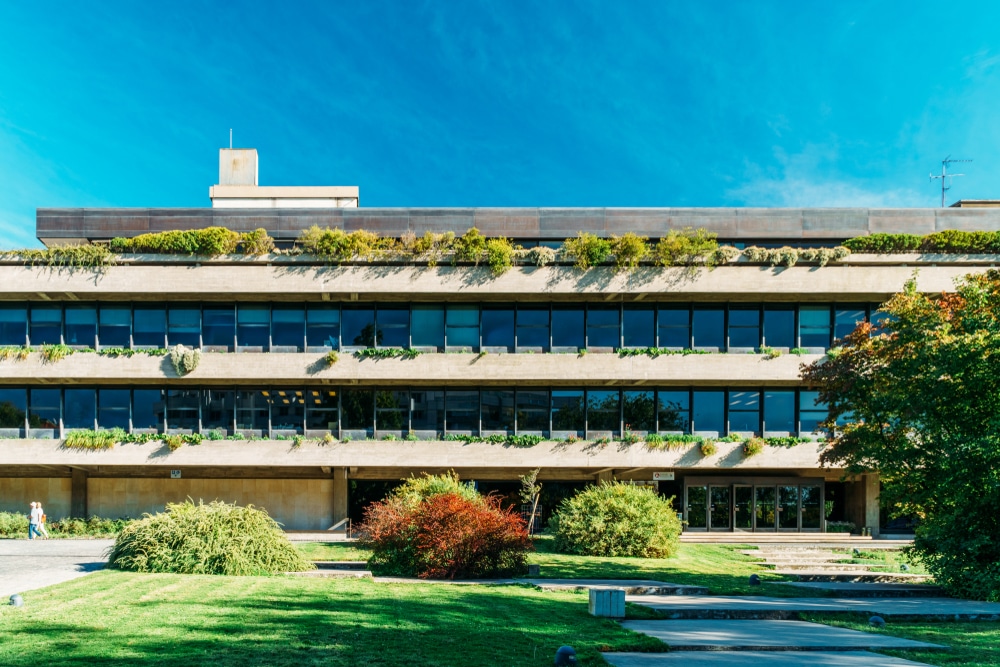 Source: Radu Bercan / Shutterstock
Source: Radu Bercan / ShutterstockThe British-Armenian oil magnate Calouse Gulbenkian (1869-1955) played a key role in the western development of the Middle East’s oil industry. So, unsurprisingly, he amassed an incredible fortune, as well as an art collection for the ages.
This was too large for him to store in his homes, and one palatial townhouse on Avenue d’Iéna in Paris was thought to be crammed with art in the 1930s.
At his death the collection ran to more than 6,400 pieces, all bequeathed to a foundation and put on display in accordance with his will.
There are around 1,000 works on show at any one time in the purpose-built Calouste Gulbenkian Museum (1969), presented chronologically.
And just to give you a hint of the richness of the inventory there are pieces by Rembrandt, Rodin, Degas, Renoir, Domenico Ghirlandaio, J. M. W. Turner, Rubens, Monet and Fragonard.
The museum also has sections for Egyptian, Mesopotamian, Greco-Roman and Islamic Art, along with an astounding array of jewellery by René Lalique, personally commissioned by Gulbenkian.
Website: https://gulbenkian.pt/museu/en/
7. Praça do Comércio (Terreiro do Paço)
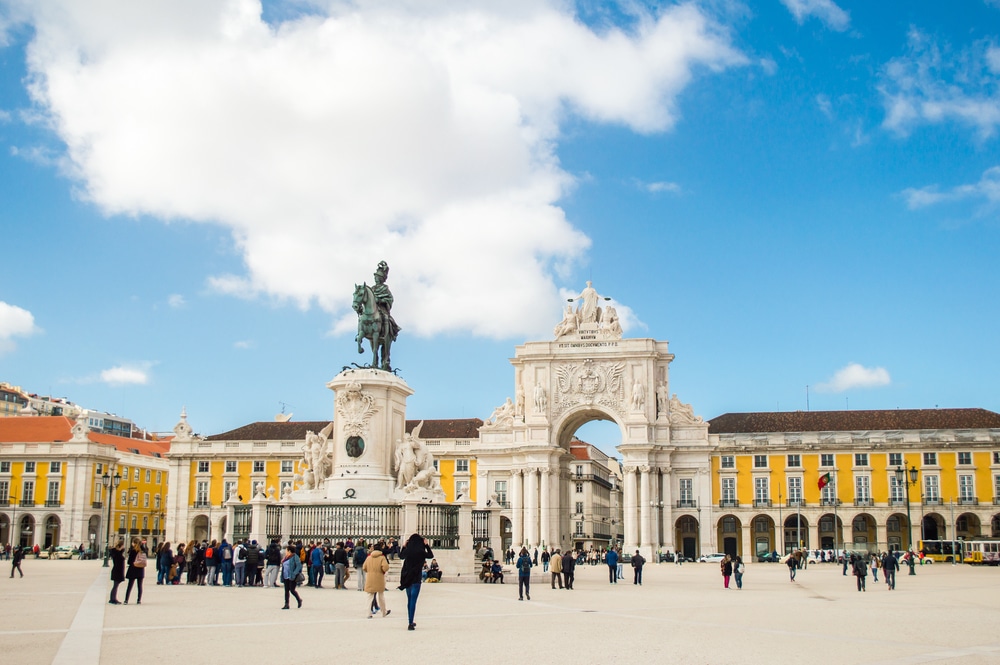 Source: Andrii Lutsyk / Shutterstock
Source: Andrii Lutsyk / ShutterstockAfter it was laid to waste by the 1755 earthquake, Lisbon’s downtown bounced back in spectacular fashion with a planned, symmetrical cityscape overseen by the Marquis of Pombal (1699-1782).
One of the major projects was this magnificent waterfront plaza, on the site of the Ribeira Palace, the seat of the royal family for 250+ years, but toppled in the earthquake.
The Praça do Comércio that took its place was conceived as a glorious point of entry for royalty and statesmen arriving in Lisbon by water.
The square is walled on three sides by arcades and centres on a regal horseback statue of King José I (1714-1777), by the preeminent sculptor Machada de Castro.
This is on an axis with the colossal Rua Augusta Arch, raised to commemorate the city’s reconstruction.
The arrow-straight pedestrian shopping street of the same name, packed with cafe and restaurant terraces, conveys you up to another landmark square at Praça do Rossio.
8. Bairro Alto
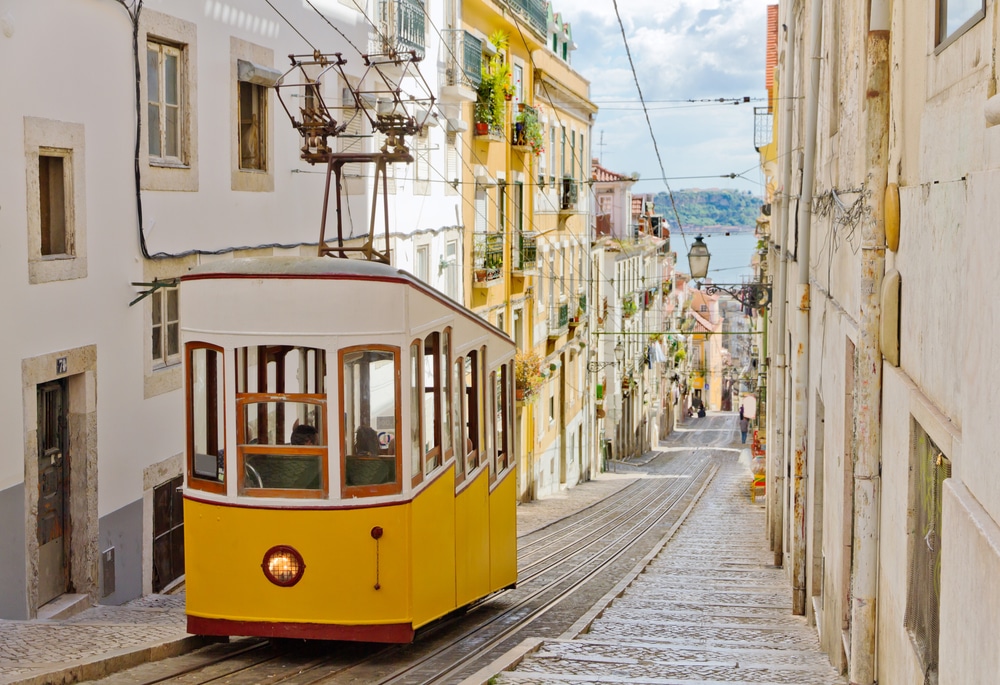 Source: Martin Lehmann / Shutterstock
Source: Martin Lehmann / ShutterstockRising west of Lisbon’s Pombaline planned city that was laid out following the earthquake in 1755 is an older grid of narrow streets that took shape earlier.
The endearing Bairro Alto was built after a separate disaster, an earthquake and tsunami that struck the capital in 1531.
Cultivating a louche reputation that reaches back hundreds of years, Bairro Alto is another neighbourhood suffused with the plaintive sound of Fado in the evenings.
Right up to the end of the 20th century, Portugal’s most important newspapers were based in this quarter and it is long associated with students, writers, artists and progressive thinkers.
Since the 1980s Bairro Alto has been the place to go out in Lisbon, bursting with restaurants, bars and no lack of Fado houses.
By day, come to discover the eye-catching street art on centuries-old walls and to ride the iconic Ascensor da Bica, trundling up the slope from the Pombaline downtown.
9. São Jorge Castle
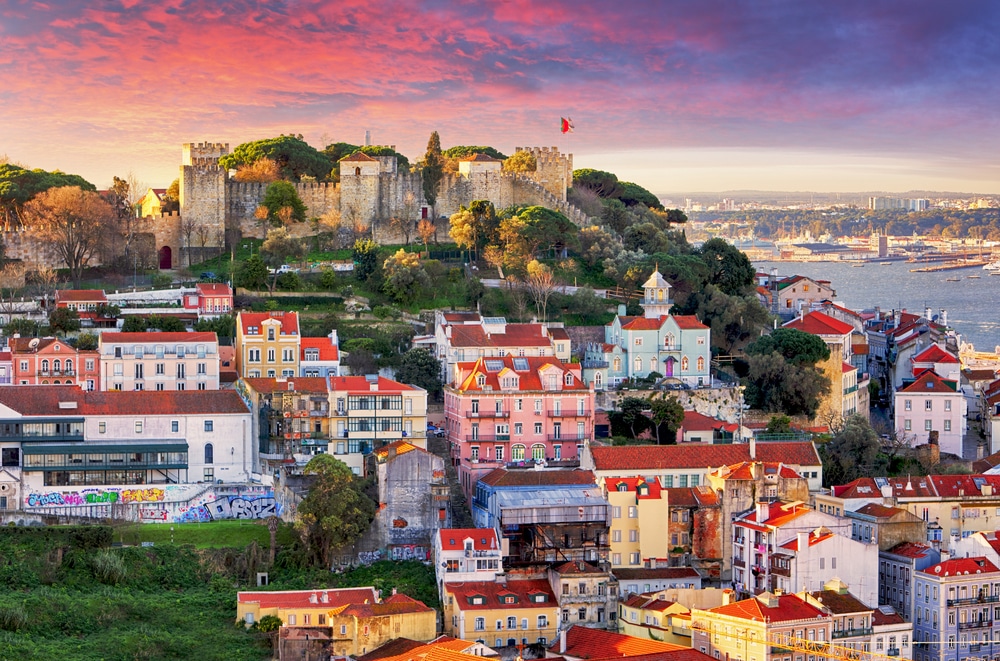 Source: TTstudio / Shutterstock
Source: TTstudio / ShutterstockThe tallest hill in Lisbon has been fortified since time immemorial, with archaeological finds at this spot going back more than 2,800 years.
The current São Jorge Castle has Moorish origins from the 10th century and was captured by Afonso I during his retaking of Portugal in 1147.
This fortification, with eleven towers, witnessed some crucial moments in Portuguese Medieval history, as the seat of kings, withstanding Castilian sieges in the 14th century and staging events like the reception for Vasco da Gama in 1498 when he discovered a passage by sea to India.
The castle lost its importance in the Early Modern Age and was restored to its Medieval appearance in the 20th century. The views from the ramparts are the best in Lisbon, and in the Black Chamber there’s a camera obscura for a 360° real-time panorama of the city.
You can check out the castle’s various layers of history at the archaeological site, and there’s a small permanent exhibition outlining each chapter in Lisbon’s storied past.
Website: http://castelodesaojorge.pt/site/en/
10. Carmo Convent
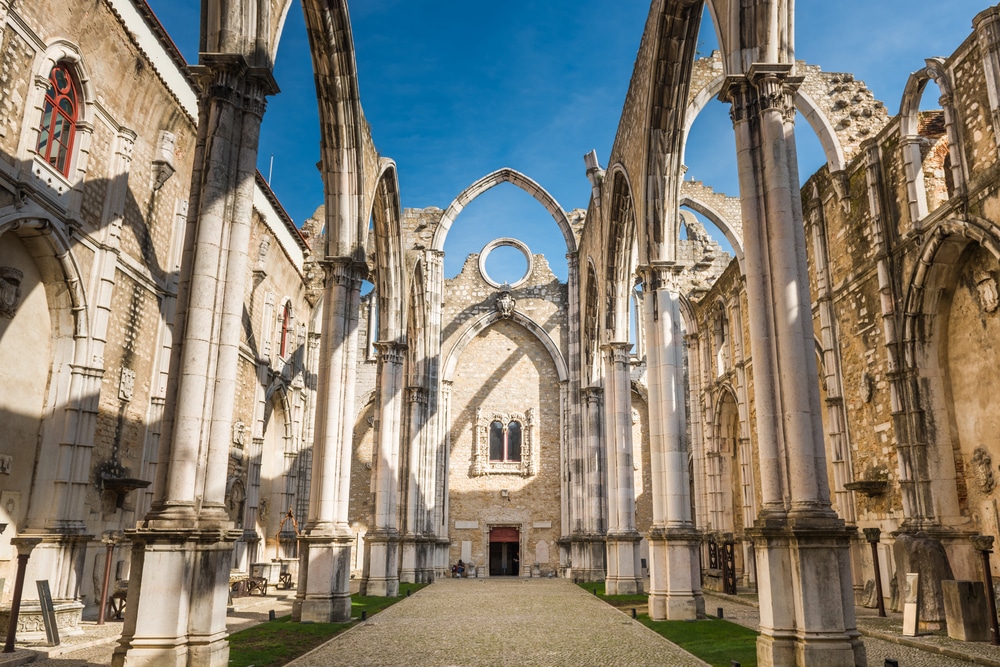 Source: tichr / Shutterstock
Source: tichr / ShutterstockA stirring monument to the havoc wreaked by the 1755 Lisbon Earthquake can be seen at the remnants of a Gothic church constructed at the turn of the 15th century for the Carmelite order. Although the roof of the nave is gone, there’s a lot of lovely Gothic stonework to admire.
You’ll find this on the jambs, capitals and archivolts of the main portal, the remnants of the rose window on the facade, the flying buttresses supporting the south wall and the pointed arches in the nave, held up by capitals with vegetal motifs.
The nave and apse has become an archaeological museum, housing vestiges recovered across the city.
On display is a Roman tomb carved with reliefs depicting the muses, a Visigothic pillar, a host of Medieval tombs, ceramics, mosaics and coins going back to the 1200s.
One curiosity that draws the crowds is a room devoted to mummies, among them a pair of pre-Columbian girls from Peru, donated to the museum by its founder.
11. Miradouro da Senhora do Monte
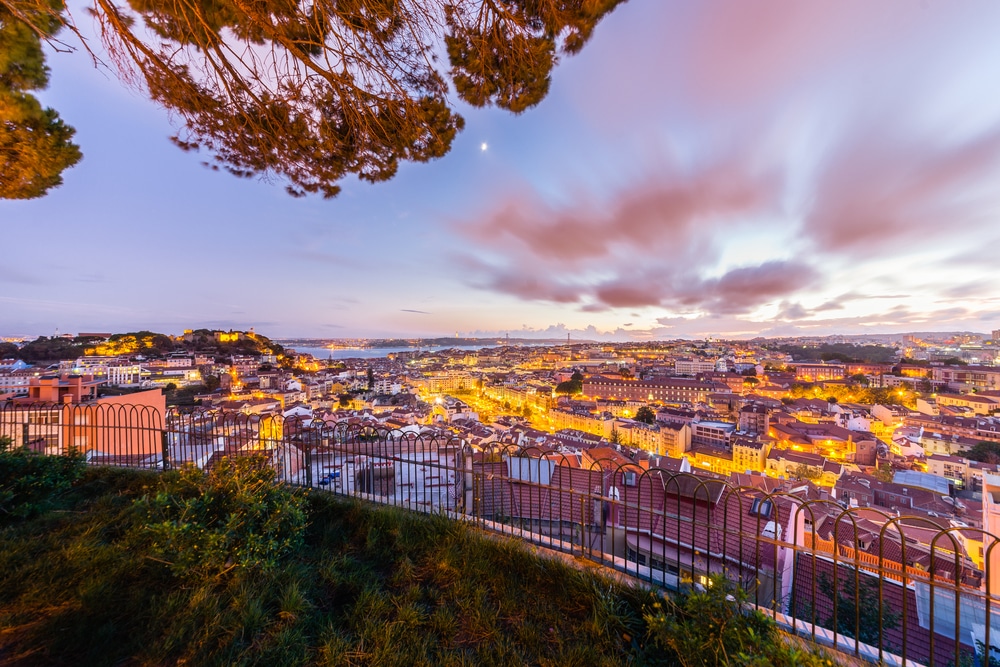 Source: Tamas Gabor / Shutterstock
Source: Tamas Gabor / ShutterstockLisbon’s topography gives rise to some awesome panoramas, and possibly the best is on this hill, which served as the base for Afonso I’s reconquest of the city in 1147.
The chapel next to the belvedere was built directly after the reconquest, and rebuilt in 1796 after the 1755 earthquake.
As for that view, you’ll get an almost bird’s eye perspective of the squares, avenues and monuments of Lisbon Baixa, the planned city laid out in the decades after the earthquake.
Beyond this are the Tagus and the 25 de Abril Bridge, while on the hilltop directly to the south you’ll see the crenellated towers of the São Jorge Castle.
Shaded by pines, the belvedere has little orientation panels made with tiles, and partly faces west for gorgeous scenery at sunset.
12. Chiado
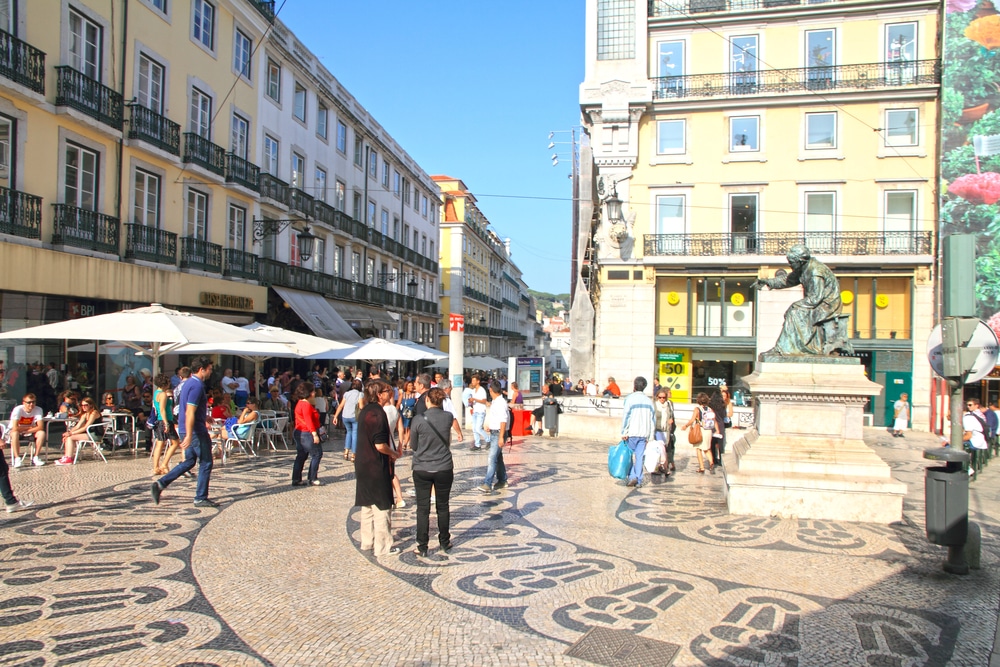 Source: Ana del Castillo / Shutterstock
Source: Ana del Castillo / ShutterstockAnother of Lisbon’s emblematic neighbourhoods, the cosmopolitan Chiado has a special place in the city’s heart thanks to its literary tradition, as the hotbed of Portuguese Romanticism in the mid-19th century.
Chiado has held on to its culture as a theatre district, and is also big with shoppers, combining international chains and long-standing local shops on lively streets like Rua Garrett.
Some of Chiado’s mainstays on this street have been here for a long time, like Livaria Bertrand, dating back to 1747, and the Paris em Lisboa fashion/homewares store, from 1888.
In 1988 the neighbourhood was wracked by a fire that claimed 17 buildings, and the acclaimed reconstruction was led by architect Álvaro Siza Vieira.
One monument that needs to be seen is the 16th-century Igreja de São Roque, the first Jesuit church in Portugal, and the main church for the order for more than two centuries up to their expulsion in 1759.
This building survived the earthquake of 1755 and has astonishing decoration, including a Mannerist trompe-l’œil ceiling on the nave, creating the illusion of a barrel vault.
13. Museu Coleção Berardo
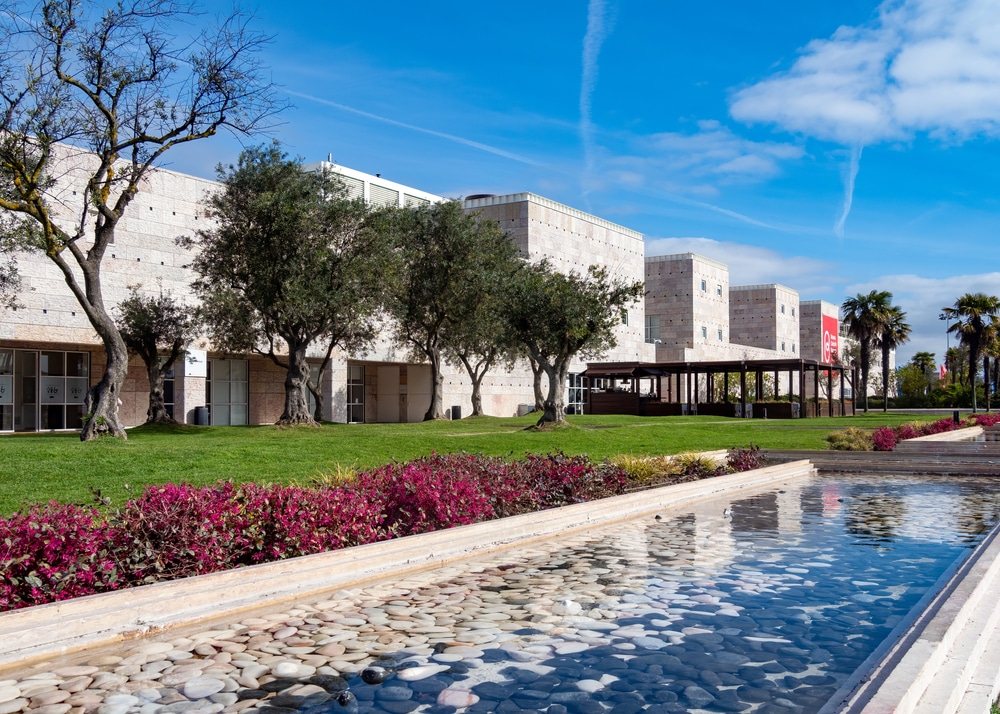 Source: Keith Hider / Shutterstock
Source: Keith Hider / ShutterstockSince 2007 the Belém Cultural Center, close to the waterfront Padrão dos Descobrimentos (Monument of the Discoveries), has been the showcase for the phenomenal modern art collection amassed by businessman Joe Berardo.
The Berardo Collection encompasses almost every 20th-century movements, from Fauvism to Minimalism, and has works by an august roll-call of artists including Mondrian, Picasso, Warhol, Chagall, Francis Bacon, Jackson Pollock, Joan Miró and Salvador Dalí.
The permanent exhibition is presented in chronological order, to give the impression of a trip through time, while there’s an exciting program of temporary shows, featuring Julian Opie and Andreas H. Bitesnich in recent years.
Website: https://en.museuberardo.pt/
14. Museu Nacional dos Coches (National Coach Museum)
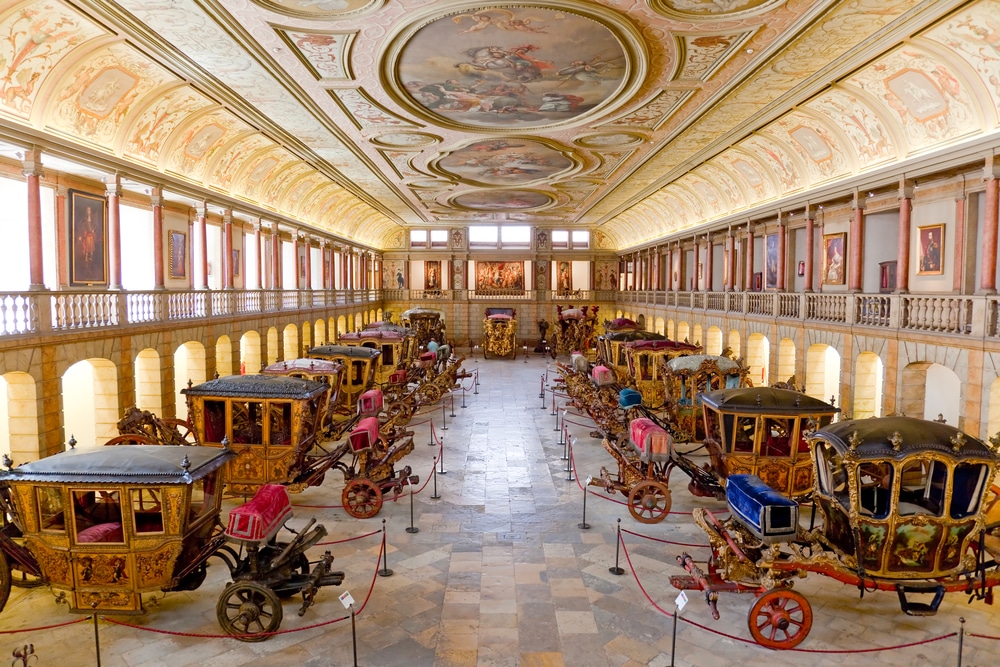 Source: StockPhotosArt / Shutterstock
Source: StockPhotosArt / ShutterstockPart of the historic Belém Palace complex, which is now home to the President of Portugal, this museum was created by Queen Amélie in 1905.
The National Coach Museum is housed in a Neoclassical equestrian arena from 1828, as well as a contemporary building unveiled in 2015.
Simply put, this is the foremost museum in its field in the world, presenting an enchanting array of sedans, litters, chaises, carriages, ceremonial coaches and many more vehicles, dating from the 16th to the 19th centuries.
Among the museum’s most noteworthy exhibits is the coach used by Spain’s Phillip III on his visit to Portugal in 1619.
Also make sure to see the extraordinarily opulent giltwork on the Italian Baroque coaches from the early 18th century, gifted to King John V by Pope Clement XI or used by the Portuguese ambassador to the same pontiff.
Also in the collection are oil portraits of the Braganza monarchs, harnesses, 18th-century armoury items and historic coach service liveries.
Website: http://museudoscoches.gov.pt/en/
15. Oceanário de Lisboa
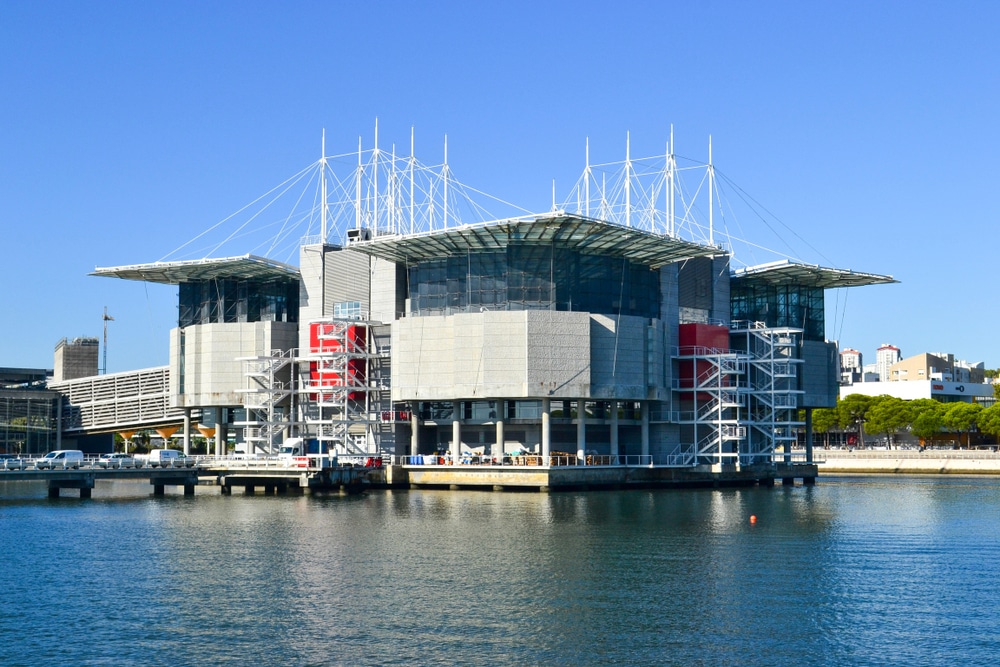 Source: franka555 / Shutterstock
Source: franka555 / ShutterstockAn apt attraction for a nation that set its gaze on the seas, the Oceanário de Lisboa opened in Parque das Nações, a new city quarter completed for Expo ’98.
More than 20 years later this is still Europe’s largest indoor aquarium, all organised around a massive central tank that holds five million litres.
There are around 100 species in this tank alone, counting various sharks, rays, grouper, barracuda and one of the few sunfish in any aquarium in the world.
Four smaller tanks around the main one are dedicated to specific regions, like the kelp forests of the Temperate Pacific, the Antarctic Coast, Tropical Indian coral reefs and the rugged North Atlantic coast.
Among the Oceanário’s 450 species are sea otters, birds like puffins and penguins, amphibians including axolotls, frogs and salamanders.
Website: https://www.oceanario.pt/en
16. Palácio dos Marqueses de Fronteira
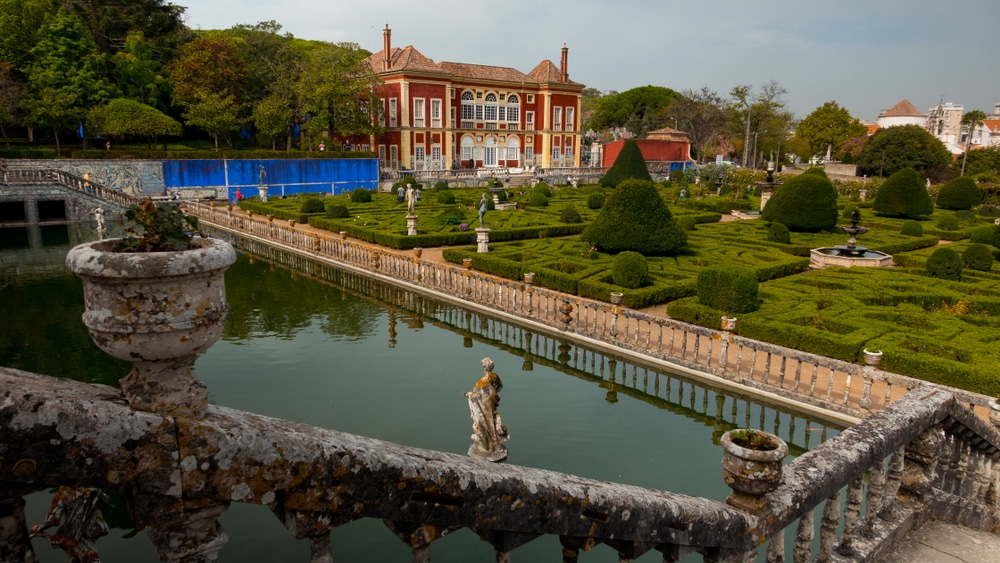 Source: Filipe.Samora / Shutterstock
Source: Filipe.Samora / ShutterstockJoão de Mascarenhas, 1st Marquis of Fronteira ordered this Mannerist and Baroque palace as a hunting lodge in the early 1670s.
The property, in sublime gardens, is still in the hands of the marquis’ successors, but is open to the public for guided tours. You’ll find it on the edge of the Parque Florestal de Monsanto, which dominates much of western Lisbon.
What makes the palace a must-see is its extensive use of azulejos, cladding almost every available surface both indoors and out.
These are regarded as some of the finest in Portugal, and vary in theme, showing battles, hunting scenes and episodes from the bible.
The high point inside is the exceptional Sala das Batalhas (Room of Battles), with scenes from the War of Restoration, including an image of João de Mascarenhas himself.
You can tour the gardens without a guide, admiring yet more exquisite tilework, in one instance showing the family’s ancestors on panels reflected in a large basin. From here a stairway leads to a terrace lined with the busts of the Kings of Portugal in niches.
Website: https://fronteira-alorna.pt/?lang=en
17. Miradouro de São Pedro de Alcântara
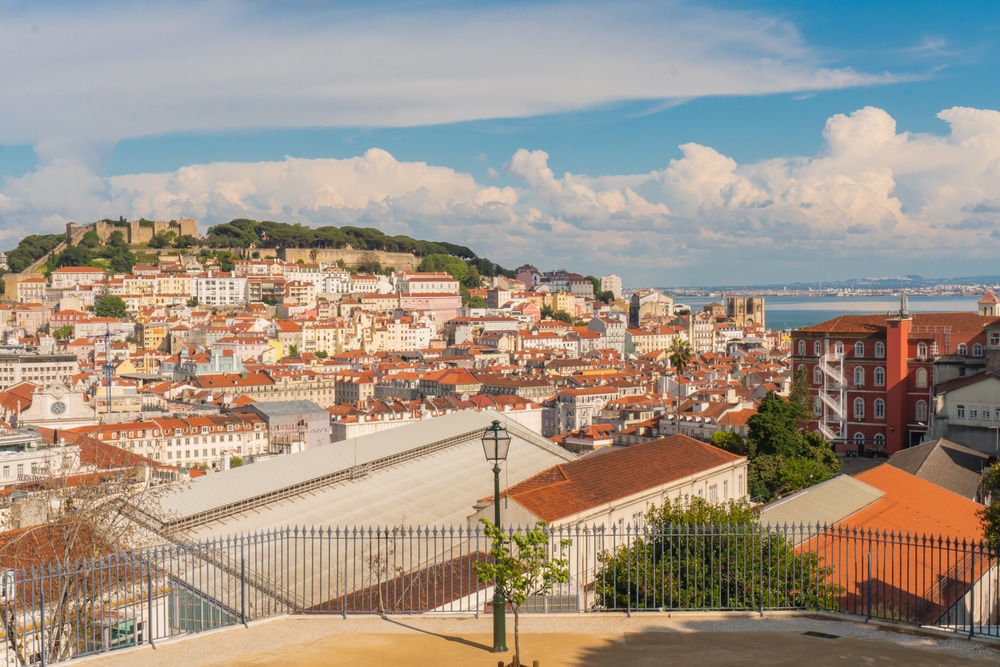 Source: atnadro / Shutterstock
Source: atnadro / ShutterstockYou can catch the Ascensor da Glória funicular up to the Bairro Alto from Restauradores Square, and it will deposit you at another sensational lookout.
From the two beautifully landscaped terraces at the Miradouro de São Pedro de Alcântara there’s a sparkling view over the Pombaline heart of the city and its many landmarks.
You can identify those palaces and churches with the help of a lovingly crafted map made from azulejos on the upper terrace. There you’ll find rows of trees, a central fountain and a little cafe in the corner.
If you’ve just got into town, this viewpoint will give you a feel for Lisbon’s unique topography, and will see the towers of São Jorge Castle peeking through its pine woodland.
Turn to the south and you’ll see the Tagus, all the prettier at sunset. The lower terrace is a formal garden embellished with busts of figures from Greek and Roman mythology.
18. Museu de Marinha
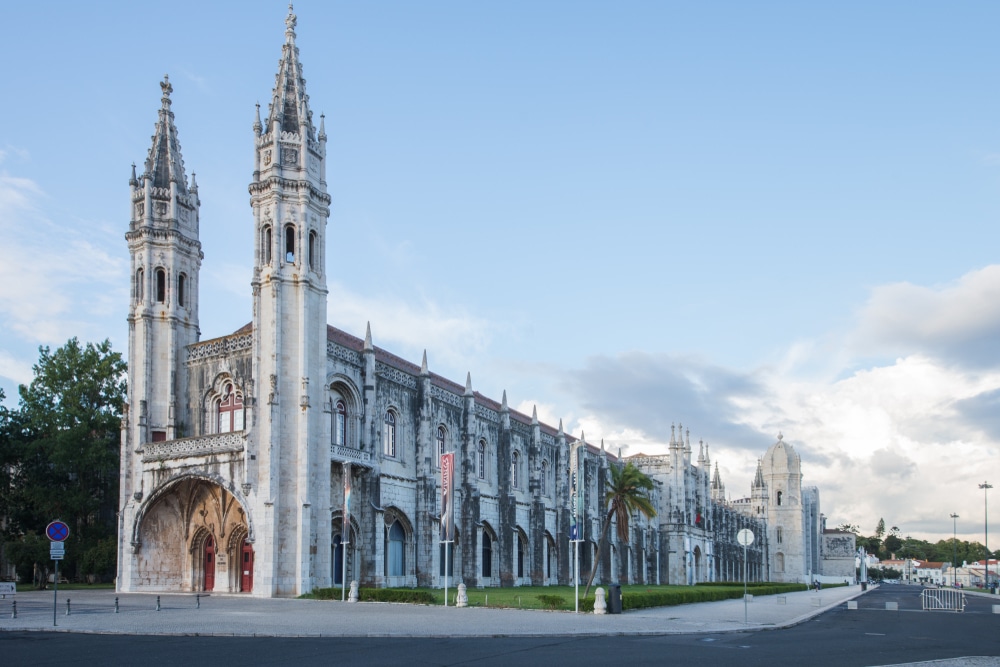 Source: Tamas Gabor / Shutterstock
Source: Tamas Gabor / ShutterstockIt makes sense that a museum for the history of Portuguese navigation should be housed in the Jerónimos Monastery, which was funded by trade with Africa and the Orient and built for explorers.
Run by the Portuguese Navy, the Museu de Marinha was inaugurated in the neo-Manueline western wing of the complex in 1963, a century after this institution was founded by King Luís I.
Over the last 160-odd years the museum has built up a vast collection, with 6,000 items on display at any time.
You can browse antique navigational instruments, sea charts, weapons, uniforms, as well as a large array of model ships for everything from galleys to ocean liners.
The main exhibition explains how Portuguese influence spread around the globe from the Middle Ages through the Age of Discovery.
There are some wonderful artefacts from the nation’s royal history, like the preserved cabins from Amélia, the royal yacht acquired in 1901, as well as a small fleet of royal barges and yachts in the large Gaillot Pavilion.
19. Lisbon Cathedral
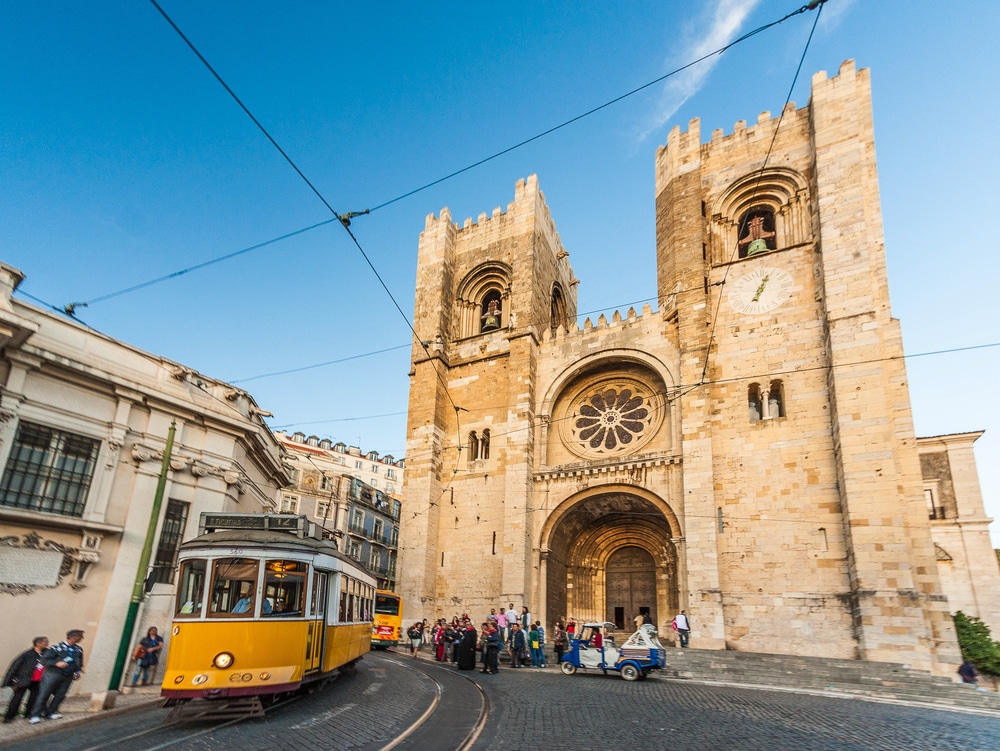
The oldest church in Lisbon was built on top of the main mosque following the reconquest from the Moors by Afonso I in 1147.
In a city beset by earthquakes, Lisbon Cathedral has weathered a succession of catastrophes, the largest of which was the earthquake of 1755, which among other things destroyed the royal pantheon ordered by Afonso IV in the 14th century.
The reconstruction would continue well into the 20th century, and the building has a mix of architectural styles from Romanesque to Baroque.
The oldest, Romanesque architecture from the 12th century can be seen in the rebuilt west facade, where there’s a beautiful rose window above the portal, which has sculpted capitals in its jambs.
Although Afonso IV and the family’s tombs were lost to the earthquake, the ambulatory built to connect to that chapel survives, and has some stunning 14th-century Gothic tombs, including one for Fernandes Pacheco, 7th Lord of Ferreira de Aves, a nobleman in Afonso IV’s court.
The Treasury of the See meanwhile can be accessed via the south tower and among its statuary, ecclesiastical textiles and illuminated manuscripts is a trove of fine silverware including a cross from the 16th century.
20. Museum of Art, Architecture and Technology (MAAT)
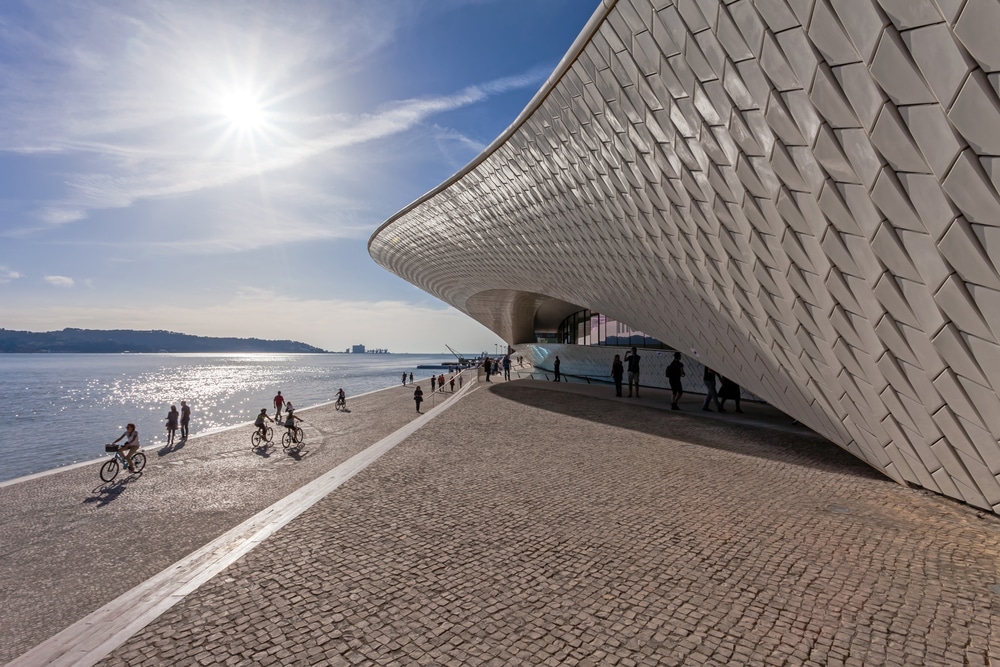 Source: StockPhotosArt / Shutterstock
Source: StockPhotosArt / ShutterstockOn the Waterfront between the 24 de Abril Bridge and the Jerónimos Monastery is a new cultural centre and a captivating 21st-century landmark for Lisbon, designed by Amanda Levete.
The cutting-edge architecture of MAAT, with its low, arcing roof, is juxtaposed with the wonderfully ornate Tejo Power Station (1909), set next door and part of the same complex. Inside you can view temporary exhibitions for art, architecture and contemporary thought.
The museum is run by a foundation set up by the electric utilities company, EDP Group, and even if you don’t go in for an exhibition, it’s all a sight worth seeing along the Tagus riverfront.
Website: https://www.maat.pt/en
21. Parque das Nações
 Source: Vadim Petrakov / Shutterstock
Source: Vadim Petrakov / ShutterstockThe 1998 Lisbon World Exposition reinvigorated an area of waterfront industry in the far north-east of the city.
More than two decades later and the main site, Parque das Nações, still holds up well, blending impressive modern architecture, gardens, striking public art and a long promenade by the Tagus with some of Lisbon’s top visitor attractions like the Oceanário de Lisboa.
Added to that you’ve got the spaceship-like form of the Altice Arena, with a capacity of 20,000 and used for concerts, conventions and sporting events.
Lisbon’s tallest skyscraper, the 140-metre Vasco da Gama Tower is here, with a framework resembling the sail of a caravel as a nod to Portugal’s seafaring history.
The Centro Vasco da Gama is a mall with 160+ stores, while the Pavilhão do Conhecimento is an interactive science and technology museum, encouraging learning through exploration.
Website: http://www.portaldasnacoes.pt/
22. Museu do Oriente
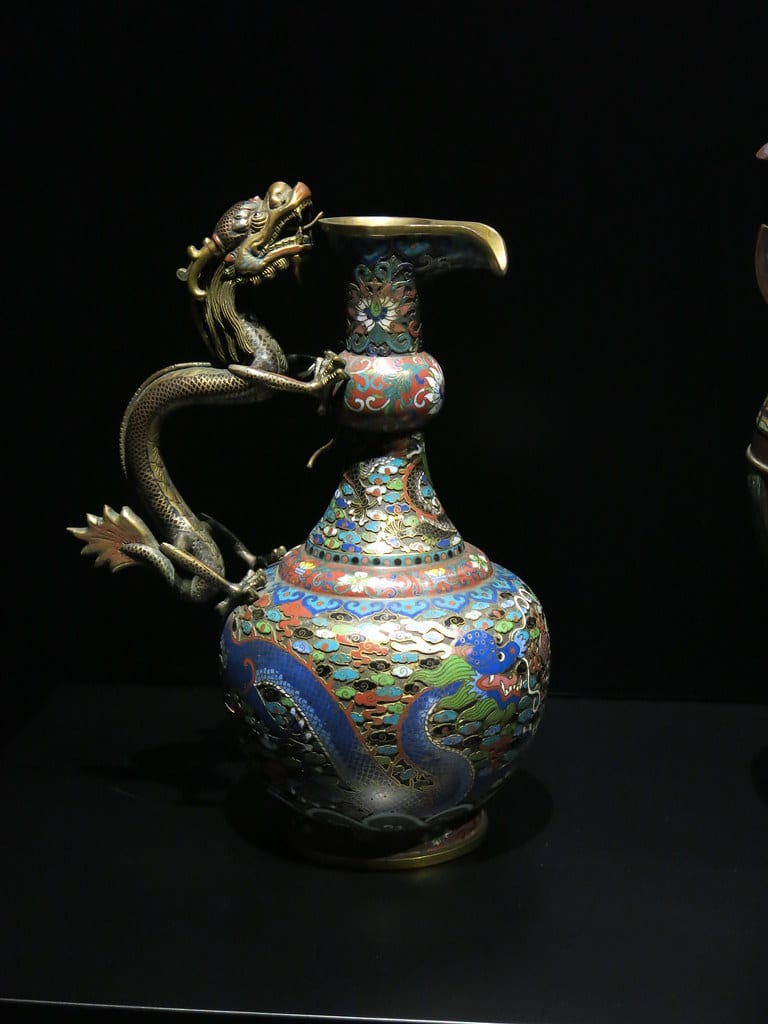 Source: dungodung / Flickr | CC BY-SA
Source: dungodung / Flickr | CC BY-SAAn Art Deco port building from the 1940s in Alcântara was repurposed for this compelling museum, which opened in 2008.
The permanent exhibition at the Museu do Oriente celebrates Portugal’s centuries-long presence in Asia, going back to the voyage of Vasco da Gama.
The bulk of the collection looks into the interplay between Portuguese and Asian cultures, comprising porcelain from the 17th-century Companhia das Índias Orientais (Portuguese East India Company), Japanese and Chinese 17th and 18th-century screens, rare Namban art and an important array of pieces from Timor.
The Kwok ON Collection meanwhile is made up of hundreds of loans from the namesake museum in Paris, including masks, shadow puppet theatres and fascinating exhibits relating to Hindu, Buddhist, as well as shamanic and animistic worship.
Website: http://www.museudooriente.pt/?lang=en
23. 25 de Abril Bridge
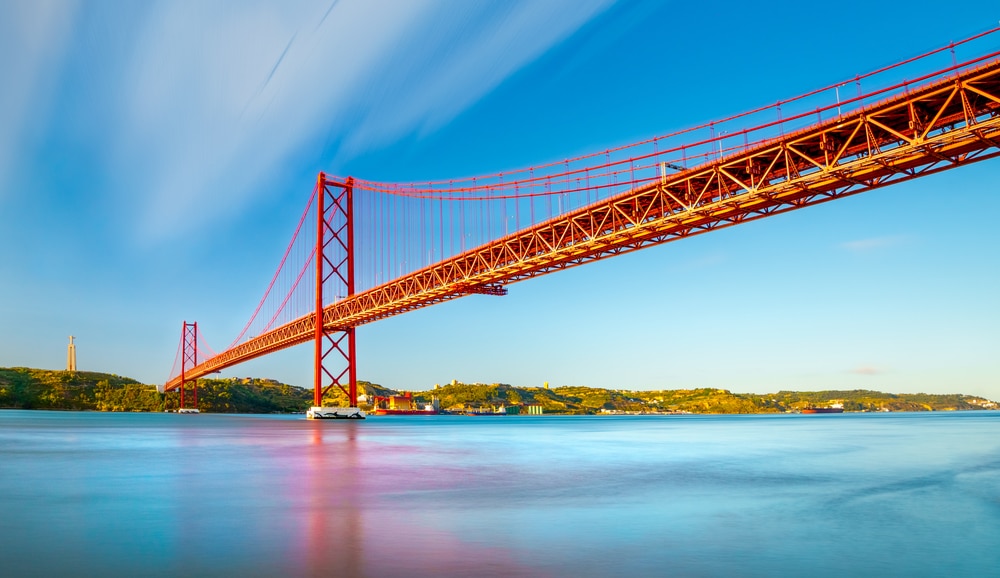 Source: LucVi / Shutterstock
Source: LucVi / ShutterstockLisbon’s first crossing on the Tagus is a monument worthy of a capital and one of the top 40 largest suspension bridges in the world.
The 25 de Abril Bridge, later named for the Carnation Revolution of 1974, was four years in construction, and opened in 1962.
With a top deck for road traffic and a lower deck carrying a railway, it measures just over 2.2 kilometres and has a maximum clearance of 70 metres over the river.
You’ll notice right away that there’s a resemblance to the Golden Gate Bridge, and this monument does have a connection to San Francisco as it was built by the American Bridge Company, also responsible for the San Francisco-Oakland Bay Bridge.
On the Lisbon bank there’s a little marina lined with restaurants, right under the bridge, while high on the left bank stands the imposing Christ, the King Statue, and you could visit this monument for a magnificent view of the Tagus and Lisbon.
24. Vasco da Gama Bridge
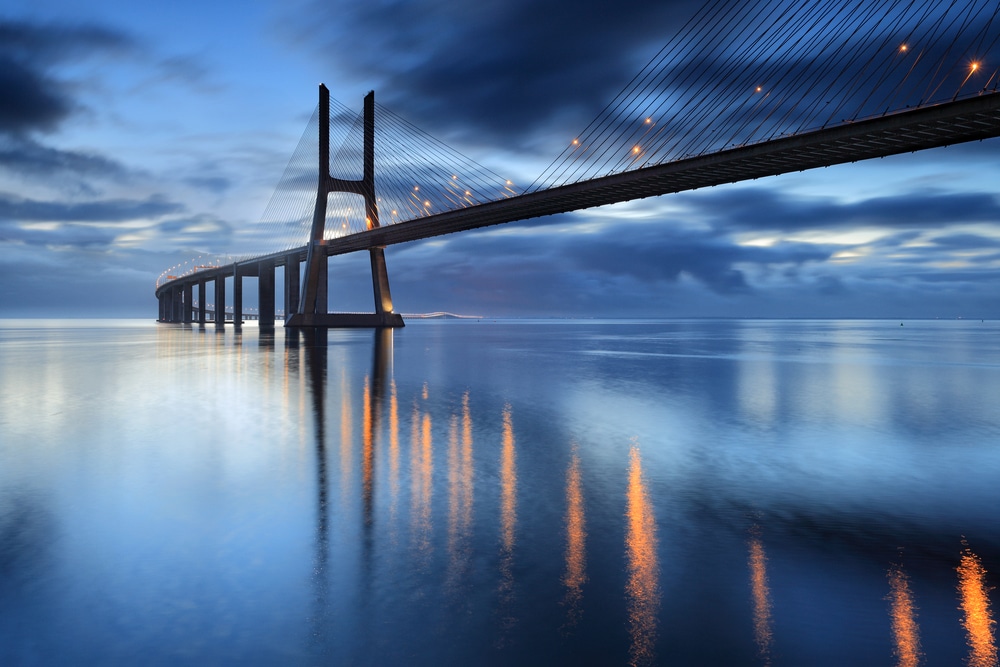 Source: ARoxoPT / Shutterstock
Source: ARoxoPT / ShutterstockFor fans of megastructures, the longest bridge in the EU touches land just north of the Parque das Nações and opened in time for Expo ’98 after three years of construction.
This all coincided with the 500th anniversary of Vasco da Gama’s discovery of a maritime route from Europe to India.
The bridge is 12.3 kilometres long, and curls across the Tagus to Samouco on the left bank, easing pressure on the 25 de Abril Bridge, which until ’98 had been the main road crossing.
The westernmost section is cable-stayed, while for the next 11.5 kilometres the crossing is supported by viaducts. If you fancy heading across by road, there’s a toll for northbound traffic heading back into Lisbon.
25. Museu do Fado
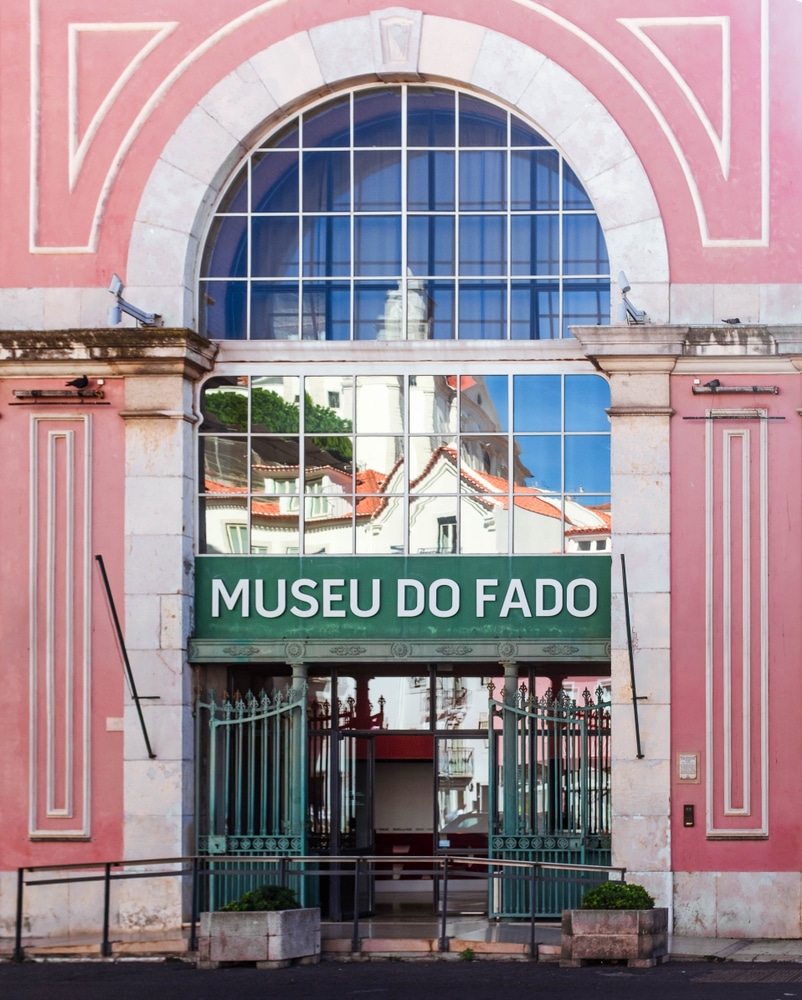 Source: Dace Kundrate / Shutterstock
Source: Dace Kundrate / ShutterstockSpend any time in the Bairro Alto or Alfama and you may fall in love with this traditional art-form, which originated in Lisbon in the 1820s and has UNESCO Intangible Cultural Heritage listing.
So a perfect follow-up is this museum, a brief walk along the Tagus from Praça do Comércio. You’ll learn about the working-class origins and evolution of Fado music, as well as its distant forbears in African chants, Moorish music and Medieval lyric poetry.
The museum will also introduce you to the theme of “saudade” (longing) in its lyrics, the many different sub-categories of Fado and how it was censored under the Estado Novo regime in the 20th century.
You can navigate the exhibits with an English audio guide and get to know some of the most treasured songs and artists via interactive stations.
Website: https://www.museudofado.pt/en